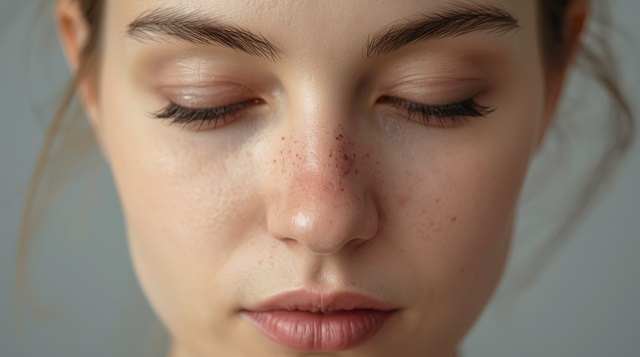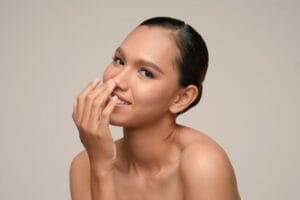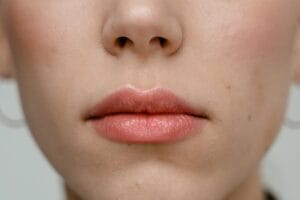How Skin Type Affects Rhinoplasty: What You Need to Know
When Sarah walked into my consultation room, she had one burning question: “Will my oily skin mess up my rhinoplasty results?” It’s something I hear constantly—people wondering if their skin type will somehow sabotage their dream nose. The truth is, skin type absolutely matters in rhinoplasty, but probably not in the way most people think. It doesn’t determine whether you’ll look good after surgery; rather, it shapes how your surgeon approaches the procedure and what kind of recovery timeline you can expect. Here’s the thing: your skin type affects rhinoplasty in ways that go beyond surface-level concerns.
It influences everything from surgical technique selection to healing patterns to the final aesthetic outcome. Some patients with thick skin worry they won’t see definition, while those with thin skin fear their results will look too sharp or unnatural. Both concerns are valid, but understanding how skin type affects rhinoplasty helps set realistic expectations and ensures your surgeon can deliver optimal results.
Question: How does skin type affect rhinoplasty?
Answer: Skin type significantly affects rhinoplasty in several ways. Thick skin requires more aggressive structural changes and leads to longer healing times (12-18 months), while thin skin allows quicker visible results but shows more detail—including any imperfections. Skin type influences surgical technique selection, recovery timeline, swelling patterns, and final aesthetic outcomes. Surgeons modify their approaches—from cartilage framework design to suturing methods—based on each patient’s specific skin characteristics.
Understanding Skin Types in Rhinoplasty Context
Before we dive deeper, let’s clarify what surgeons actually mean when they talk about skin types affecting rhinoplasty. We’re not talking about whether you have dry, oily, or combination skin in the traditional dermatological sense—though those factors do play a role in healing. Instead, the primary concern is skin thickness and elasticity, which vary dramatically from person to person.
Skin thickness isn’t uniform across your entire face, either. The nasal skin tends to be thicker in certain areas (like the tip and alar regions) and thinner over the bridge. This natural variation already complicates rhinoplasty planning, but add in individual differences in skin characteristics, and you’ve got a surgical puzzle that requires careful, personalized solving.
What many patients don’t realize is that skin type affects rhinoplasty planning long before the actual surgery happens. During your consultation, your surgeon is evaluating several key factors: skin thickness, sebaceous gland activity, elasticity, and underlying blood supply. Each of these elements informs surgical decisions that can make or break your results.
How Thick Skin Affects Rhinoplasty
Thick skin presents unique challenges—and opportunities—in rhinoplasty. Patients with thicker nasal skin often worry their new nose structure won’t show through, but that’s not necessarily true. The key is understanding what “thick skin” actually means in this context.
Dermatologically speaking, thick skin in rhinoplasty refers to skin that has:
- More subcutaneous tissue and fat layers
- Higher sebaceous gland density (those oil-producing glands)
- Denser connective tissue structures
- Often, increased vascularity
When skin type affects rhinoplasty for thick-skinned patients, the surgical approach shifts significantly. Surgeons working with thick skin need to create more pronounced structural changes because the skin won’t conform as tightly to the underlying framework. Think of it like trying to see the shape of your hand through a thick winter glove versus a thin latex glove—the thicker covering requires a more defined structure underneath.
Here’s what makes thick skin rhinoplasty particularly tricky: the healing process tends to be more unpredictable. Swelling lingers longer, sometimes for up to 18 months or even two years in extreme cases. That’s because thicker tissue simply takes more time to settle and contract around the new nasal framework. Patients often see their results continue to refine for much longer than their thin-skinned counterparts.
But here’s the silver lining—thick skin offers natural protection. Patients with thicker skin are less likely to develop visible irregularities or see through their skin to the underlying cartilage structure. The extra tissue acts as a buffer, smoothing out minor imperfections and creating a more forgiving aesthetic canvas.
How Thin Skin Affects Rhinoplasty
Thin skin in rhinoplasty is a double-edged sword. On one hand, it allows for more refined, delicate results that show definition beautifully. On the other hand, it leaves little room for error and can reveal even minor structural irregularities.
When skin type affects rhinoplasty for thin-skinned individuals, the surgeon’s work becomes more visible—both the successes and potential imperfections. Every contour change, every cartilage refinement, every subtle adjustment shows through the thin skin envelope. This means the surgical technique needs to be exceptionally precise, with careful attention to creating smooth transitions and avoiding any sharp edges or irregularities.
The healing timeline for thin skin tends to be faster initially—you might see your results taking shape within 3-6 months rather than 12-18. But the flip side is that the final outcome appears more quickly, which can be jarring if you’re not mentally prepared for such dramatic immediate changes.
One aspect patients often overlook: thin skin is more prone to visible vascular patterns. Those tiny red lines or slight discolorations you might notice? That’s the underlying blood supply showing through. It’s usually temporary, but it’s something to discuss with your surgeon beforehand.
Thin skin also requires more protective surgical techniques. Surgeons typically use soft tissue grafts or other protective measures to prevent the skin from thinning even further or developing adhesions to the underlying cartilage. Without these precautions, thin skin can become adherent to the nasal framework, creating unnatural-looking indentations or contour irregularities.
Oily vs. Dry Skin: The Overlooked Factor
Most discussions about how skin type affects rhinoplasty focus on thickness, but the surface characteristics matter too. Oily skin, characterized by overactive sebaceous glands, brings its own set of considerations.
Patients with oily skin often have thicker skin overall because sebaceous glands contribute to the skin’s structural density. But beyond thickness, oily skin affects rhinoplasty healing in specific ways. The increased oil production can impact wound healing, potentially leading to slower resolution of post-surgical swelling or, in some cases, increased risk of certain types of scarring.
Here’s where it gets interesting: oily skin also affects how sutures heal and how incisions close. Some surgeons adjust their closure techniques based on sebaceous gland activity, using specialized suturing methods that account for the skin’s natural oiliness. It’s one of those subtle technical details that separates experienced rhinoplasty surgeons from novices.
Dry skin, meanwhile, presents different challenges. Dry, thin skin can be particularly fragile during the healing period, requiring more intensive moisturization and careful wound care. Patients with naturally dry skin may experience longer healing times for external incisions (like those used in open rhinoplasty), and they’re more susceptible to scabbing and crusting during the early recovery phase.
The key takeaway? Surface skin characteristics—whether oily or dry—don’t prevent rhinoplasty, but they do inform your surgeon’s approach to incisions, closure, and postoperative care protocols.
Ethnic Variations: How Skin Type Affects Rhinoplasty Across Populations
This is where discussions about skin type affecting rhinoplasty get particularly nuanced. Different ethnic backgrounds correlate with different skin characteristics, and these variations require culturally sensitive, technically precise surgical approaches.
African American and Latino patients often have thicker skin with more sebaceous activity, which affects rhinoplasty techniques in ways that go beyond simple thickness considerations. The surgical approach needs to respect and enhance natural ethnic features while addressing the technical challenges thick skin presents. This isn’t about “Westernizing” features—it’s about working with each patient’s unique anatomy to achieve their aesthetic goals.
Asian rhinoplasty presents its own skin type considerations. Many Asian patients have thicker skin at the nasal tip combined with weaker cartilage support, creating a unique surgical puzzle. When skin type affects rhinoplasty in these cases, surgeons often employ specialized techniques like tip grafting and structural support methods that account for both the thick skin envelope and the need for enhanced definition.
Middle Eastern and Mediterranean patients frequently have thicker, oilier skin, which affects rhinoplasty healing patterns and requires longer recovery timelines. Understanding these population-level patterns helps set realistic expectations, but remember—individual variation always exists within any ethnic group.
The Surgical Techniques That Account for Skin Type
So how do surgeons actually adjust their techniques when skin type affects rhinoplasty? It comes down to several key technical modifications.
For thick skin, surgeons often:
- Create more aggressive tip definition through structural grafting
- Use larger, more stable cartilage frameworks
- Employ specific suturing techniques that help skin contract and redrape
- Consider certain types of tip refinement techniques that work better with thick skin
- Plan for more extensive undermining to allow proper skin redraping
These aren’t arbitrary choices—they’re evidence-based modifications that compensate for the skin’s natural resistance to conforming tightly around the new framework.
Thin skin requires almost opposite approaches:
- More conservative structural changes to avoid visible irregularities
- Smoother cartilage edges and refined tip work
- Protective grafting techniques that prevent skin adherence
- Often, more delicate suturing methods
- Careful attention to creating smooth transitions rather than sharp definition
The surgical approach adapts because when skin type affects rhinoplasty, one-size-fits-all techniques simply don’t work. Your surgeon should explain how they’re modifying their standard technique based on your specific skin characteristics.
Recovery Expectations: How Skin Type Affects Healing Timeline
This might be the most practical question patients have: “How long until I see my final results if I have thick/thin skin?”
When skin type affects rhinoplasty recovery, the timeline diverges significantly. Thick-skinned patients need to brace themselves for a longer journey. Swelling resolution can take 12-18 months, sometimes even two years, before you see the true final result. That initial post-surgery swelling? It sticks around longer, and the gradual refinement process takes more time.
But here’s what many patients find surprising—even though the timeline is longer, thick-skinned patients often experience less dramatic day-to-day fluctuations. The swelling is more consistent and gradually decreases rather than having those ups and downs that thin-skinned patients sometimes report.
Thin skin heals faster, but “faster” comes with its own considerations. You might see 80% of your results within 6 months, which sounds great until you realize that any minor imperfections also become visible sooner. The recovery isn’t necessarily easier—it’s just different.
Both skin types require patience, but for different reasons. Thick skin needs time to contract and settle. Thin skin needs time for internal healing and scar maturation even though the external appearance stabilizes more quickly.
Common Misconceptions About Skin Type and Rhinoplasty
Let me address a few myths I hear constantly in consultations:
Myth 1: “Thick skin means I can’t get a refined nose.”
Absolutely false. Thick skin rhinoplasty requires different techniques, but skilled surgeons can absolutely achieve refined, defined results. It just takes more aggressive structural work and longer healing.
Myth 2: “Thin skin always looks better after rhinoplasty.”
Not necessarily. Thin skin shows everything—including imperfections. While it can create beautiful definition, it’s also less forgiving of surgical technique.
Myth 3: “I can’t do anything about my skin type before surgery.”
Partially true, but pre-surgical skincare can optimize your skin’s condition. Some surgeons recommend specific skincare regimens leading up to surgery to improve skin quality and healing potential.
Myth 4: “Skin type is the most important factor in rhinoplasty.”
It’s important, but it’s one piece of a complex puzzle that includes bone structure, cartilage quality, nasal function, and aesthetic goals. Don’t let skin type anxiety overshadow the bigger picture.
What to Discuss With Your Surgeon
When you’re in consultation, here’s what you should ask about how skin type affects rhinoplasty in your specific case:
- How has your surgeon modified their technique based on your skin characteristics?
- What’s a realistic recovery timeline given your skin type?
- Are there specific risks or complications more likely with your skin type?
- What can you do pre-surgically to optimize your skin’s condition?
- How will your surgeon handle any skin-related challenges during surgery?
A skilled rhinoplasty surgeon won’t just acknowledge that skin type affects rhinoplasty—they’ll explain exactly how they’re accounting for it in your surgical plan. If they gloss over this topic or dismiss your concerns, consider that a red flag.
The Bottom Line
Skin type absolutely affects rhinoplasty, but it doesn’t determine your surgical fate. Whether you have thick skin, thin skin, oily skin, or dry skin, the key is finding a surgeon who understands these nuances and adjusts their technique accordingly. Your skin type influences surgical approach, recovery timeline, and final aesthetic possibilities—but it doesn’t eliminate any of them.
The most successful rhinoplasty outcomes happen when patients understand their skin characteristics, set realistic expectations based on those characteristics, and choose surgeons with proven experience working with their specific skin type. Don’t let skin type concerns prevent you from pursuing rhinoplasty, but do make sure you’re working with someone who takes these factors seriously.
Your nose surgery is a partnership between you, your surgeon, and yes—your skin. Understanding how these elements work together sets the foundation for results you’ll love for years to come.














Post Comment